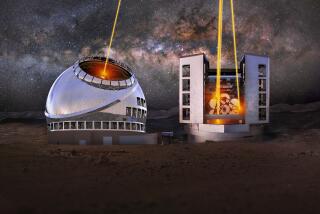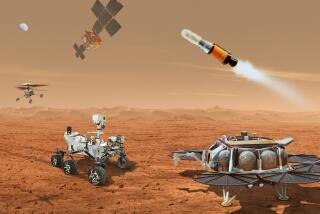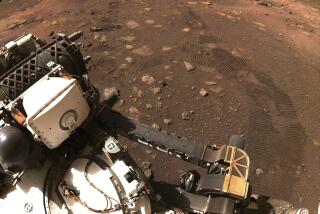Big Science--Account Out of Balance : Hubble Telescope: The problem has become all too familiar, a project oversold and under-funded.
- Share via
The history of post-World War II science is to a significant degree the history of Big Science--science characterized by many teams of people and costly apparatus.
This history reveals that such large-scale projects as the Hubble Space Telescope can be highly rewarding scientifically, but are also enormously demanding, both organizationally and technically. A number of Big Science projects have even had to be aborted after tens of millions of dollars have been spent on them. The recently announced problem with one of the Hubble’s two mirrors is the latest in a series of setbacks that have occurred over the 13 years since the start of the telescope’s construction. What lies behind the telescope’s troubled history?
Fashioning a novel and highly complex piece of high technology could hardly be free of forbidding technical obstacles. But other factors have been very important for the space telescope, too.
The telescope was first seriously considered in the mid-1960s. And a decade later there was little question that it could be built. Instead, the key question was “Is it politically feasible?” Because its cost was already being counted in the hundreds of millions of dollars, the only potential patron was the federal government. So the issue became, “Would the White House and Congress provide the funds to build the space telescope?”
In the chaotic fight to win political approval, the National Aeronautics and Space Administration repackaged, reshaped and scaled down its plans. To save money, the “large space telescope” became the more modest “space telescope” and the European Space Agency was added as an international partner. NASA also decided to drop plans to evolve slowly toward the space telescope. Instead, the space agency chose to reduce the planned testing and make a quantum leap to the technology that the telescope represented. NASA thus bypassed smaller projects entirely, making the engineering task even harder. Eager to justify and exploit the space shuttle, NASA argued that the reusable spacecraft could take care of any problems that arose once the telescope was in orbit.
Congress finally approved the telescope in 1977. But a big price had been paid: The program was both oversold and under-funded. Cost estimates were little more than NASA’s best guesses as to what size program could be sold to Congress. As a result, the program was initiated with unrealistic expectations. So NASA practically ensured that major managerial, technical and cost problems would burden the telescope’s development.
The space telescope represents Big Science of the very biggest kind. Very Big Science requires megaprojects. The image of the lone scientist toiling away in his or her laboratory is rarely accurate these days. Instead, many scientists have been drawn to large-scale enterprises by the promise of access to previously inaccessible phenomena offered by the technologies of Big Science.
In Very Big Science, a high premium is placed on the way in which all the disparate institutions, groups and individuals are arranged to fit and work together--in other words, the program’s own design. Despite the fact that NASA was in overall charge, the fragmented program design made it hard to develop the space telescope as a fully integrated system, the sum of which would be greater than its individual parts.
The telescope’s ultimate users, astronomers, generally had little power or say during development. And to compound these fundamental problems, NASA headquarters, beset by space shuttle problems, did not have the understanding, will or resources in the late 1970s and early ‘80s to fix the telescope’s difficulties. When all of these factors are taken into account, it’s no wonder that the space telescope ran into major problems.
But, regrettably, the story of the space telescope is not a freak in the recent history of American Big Science. The planned Superconducting Supercollider--intended to allow physicists to look more deeply into the fundamental structure of matter than ever before--is a gigantic particle accelerator that will be built in a 54-mile underground ring near Waxahachie, Tex. Approved by Congress in 1989 at a cost of about $5 billion, its price has now jumped to closer to $8 billion and has driven the Department of Energy to seek contributions from Korea and Japan.
What lessons, then, are to be drawn from the space telescope story, and what does it have to say about the pursuit of Big Science in late 20th-Century America? First, it is essential to define a Big Science or Very Big Science program well--scientifically, managerially, organizationally and technically--from the outset. If this is to be done, the making of science policy must be made more coherent.
A Big Science project’s advocates--in government, industry and the scientific community--should be honest with their cost estimates and avoid the crass overselling that is currently widespread. In return, if the project’s patrons--the White House and Congress--are persuaded that it is worthwhile and its objectives cannot be met by smaller-scale endeavors, they must back it through the inevitable phases of public enthusiasm and doubt. Short-term fluctuations in funding can be devastating. The nation must therefore put its aspirations for Big Science and its willingness to pay for such projects in better balance. Overselling and under-funding lead to policy failures and an erosion of trust between scientists and their patrons.
The decisions on whether or not to initiate Big Science are made by politicians. In a democracy, that is entirely right. But scientists, as the users of Big Science and those with the biggest stake in “doing it right,” must demand and secure more responsibility and oversight for the development of such projects. This means that in return, scientists should be more accountable for Big Science.
More to Read
Sign up for Essential California
The most important California stories and recommendations in your inbox every morning.
You may occasionally receive promotional content from the Los Angeles Times.










